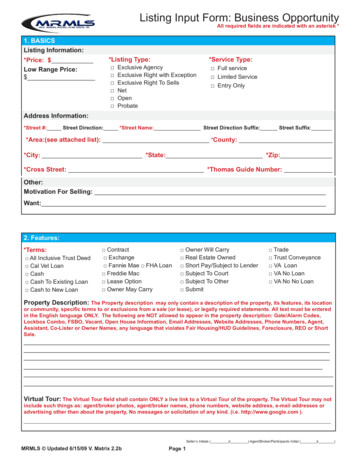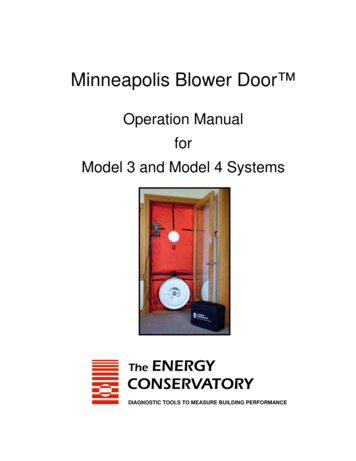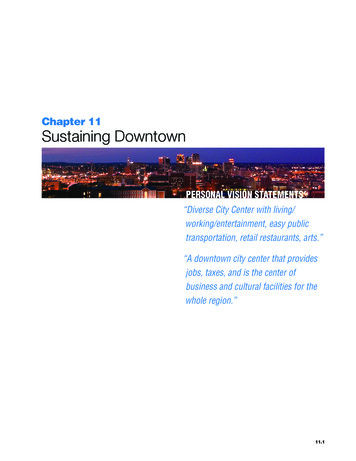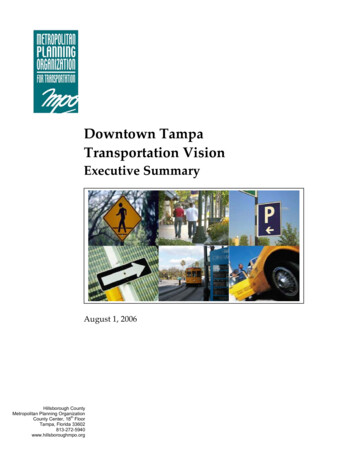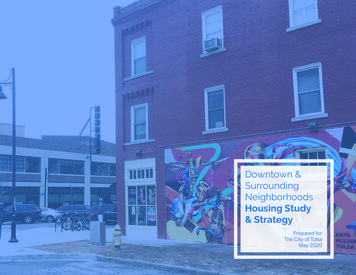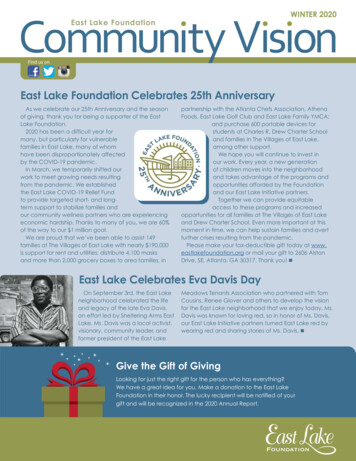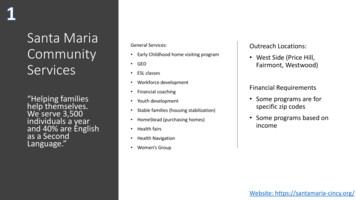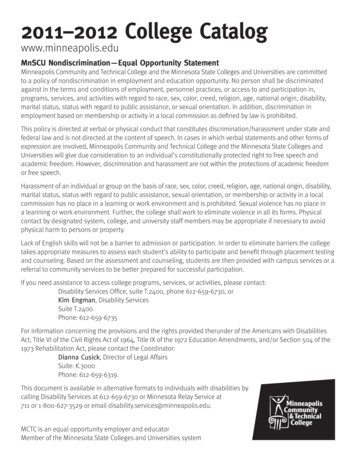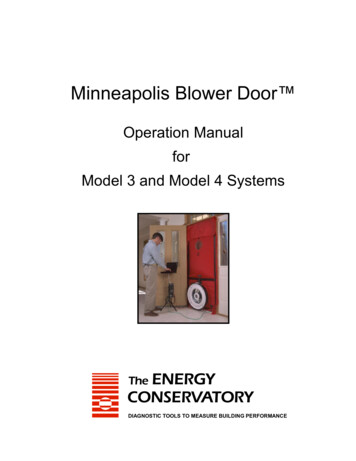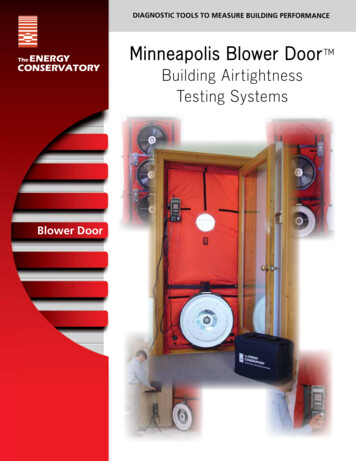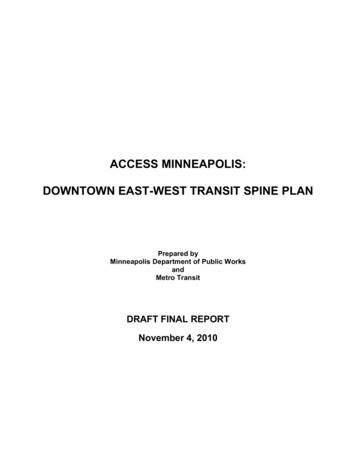
Transcription
ACCESS MINNEAPOLIS:DOWNTOWN EAST-WEST TRANSIT SPINE PLANPrepared byMinneapolis Department of Public WorksandMetro TransitDRAFT FINAL REPORTNovember 4, 2010
THIS PAGE INTENTIONALLY BLANK
Table of ContentsExecutive Summary. ES-1Purpose of East-West Transit Spine . ES-1Need for Transit Improvements . ES-1Alternative Alignments for an East-West Transit Spine. ES-2Proposed Facility and Service Improvements. ES-3Next Steps . ES-4Introduction/Background . 1Downtown Transit Spine Planning and Implementation . 1Previous East-West Transit Spine Planning . 3Purpose of East-West Transit Spine . 5Existing East-West Transit Service and Facilities . 5Alternative Alignments for an East-West Transit Spine . 13Evaluation of Alternatives . 13First Screen: Physical Constraints and Transit Service Impacts. 16Key Findings – Screen 1 . 16Screen Two: Potential Traffic Impacts . 18Number of Lanes. 18Traffic Volumes . 19Key Findings – Screen 2 . 21Screen Three: Impacts on Curbside Use, Bike Lanes, and Pedestrian Zones. 22Curbside Uses . 22Bicycle Lane Impacts. 22Pedestrian Zone Impacts . 26Key Findings – Screen 3 . 26Facility and Service Improvements. 28Existing Passenger Facilities and Streetscape Elements. 28Proposed Facility Improvements . 28Curb Extensions . 28Transit Passenger Facilities. 34Streetscape Elements . 36Service Improvements . 37Reserved Lanes for Transit . 37Operational Advantages for Transit. 37Passenger Boarding Improvements. 37Transit Operating Issues . 38Dwell and Hold Times . 38Boarding Volumes at 7th/Nicollet Bus Stop. 39Costs. 40Next Steps . 41Summary of Proposed Facility and Service Improvements. 42
List of FiguresFigure ES-1 – Proposed East-West Spine Transit Improvements . ES-5Figure ES-2 - Proposed East-West Spine Traffic Changes .ES-6Figure 1 – Existing Transit Spine Facilities. 4Figure 2 – Existing East-West Service in Downtown. 6Figure 3 – Geographic Service Areas for East-West Transit Routes. 10Figure 4 – Regional Bus and LRT Boardings by Stop . 11Figure 5 – Downtown Minneapolis Boardings by Stop. 12Figure 6 – Evaluation Process and Results . 15Figure 7 – Typical Cross-Sections. 20Figure 8 – 7th and 8th Street One-Way Pair Cross-sections . 23Figure 9 –8th Street Contraflow Lane Cross-sections . 24Figure 10 – Typical Transit Passenger and Streetscape Improvements . 33Figure 11 – Proposed E-W Spine Traffic Changes. 35List of TablesTable 1 – Characteristics of Downtown Transit Spines. 2Table 2 – Existing Local Bus Service on East-West Streets . 7Table 3 - Local E-W Spine Routes on 6th , 7th, 8th, and 9th Streets . 9Table 4 – Future (2030) Daily Bus Volumes (Express and Local) by Alternative. 14Table 5 – Future (2030) Bus Boardings (Express and Local) by Alternative . 14Table 6 – Comparison of Transit Service Impacts. 17Table 7 – Comparison of Existing Traffic Volumes. 19Table 8 – Comparison of Curbside Use Impacts and Benefits . 25Table 9 – Comparison of Pedestrian Zone Widths at Bus Stops . 26Table 10 – Comparison of Alternatives to Objectives for East-West Transit Spine . 27Table 11 – Existing Transit Facilities on Westbound 7th Street Bus Stops . 29Table 12 – Existing Transit Facilities on Eastbound 8th Street Bus Stops. 31Table 13 - Proposed Facility Improvements by Bus Stop . 36Table 14 – Existing Boardings at Bus Stops on 7th and 8th Streets. 40List of AppendicesAppendix A – Transit Routing for AlternativesAppendix B – Traffic AnalysisAppendix C – Bus Operation Characteristics
Access MinneapolisDowntown East-West Transit Spine PlanExecutive SummaryThe Minneapolis City Council adopted Access Minneapolis: Downtown Ten-YearTransportation Action Plan in June 2007. At that time, the Council directed additional study onan east-west transit spine. This report documents that additional study.Purpose of East-West Transit SpineThe purpose of an east-west transit spine is to improve transit service and to improve the qualityof transit facilities for those passengers traveling east-west through downtown. Consolidatingtransit service into “spines” concentrates financial resources, simplifies the transit system forusers, and is an efficient way to provide a very high frequency of service and a high level oftransit facilities in selected downtown corridors. This helps provide better internal downtowntransit circulation service for visitors and consumers who don’t use the transit system on aregular basis and encourages transit use for a variety of trips. The objectives of an east-westspine are to:x Provide an improved level of transit service that is fast, reliable and direct.x Provide a high quality waiting environment for transit passengers.x Provide a transit corridor with the capacity to growx Provide a high quality environment for all pedestrians.At the same time, it will be important to provide reasonable options for curbside uses, maintainreasonable traffic flow through the downtown core, and avoid impacts on existing bike lanes.Need for Transit ImprovementsA detailed transit study completed as part of the Downtown Action Plan identified the followingtransit problems in downtown:x Insufficient downtown street capacity to handle growth in transit demandx Slow and unreliable transit service, due in part to downtown street configurationsx Need for transit services that stimulate economic developmentx Need to reduce conflicts between transit and other modesx Need for better intra-downtown circulation servicex Need for better service to edge-of-downtown neighborhoodsThere was general agreement during the preparation of the Downtown Action Plan that theconcept of an east-west transit spine was desirable, but an agreement was never reached on thebest location for the spine or the best configuration for transit service. The transit routes thatwould use an east-west transit spine provide service primarily to the northwest and southeastquadrants of Minneapolis as well as the suburban communities of Brooklyn Center, Robbinsdale,Golden Valley, Minnetonka, St. Louis Park, Richfield and Bloomington. A number of majoremployers are served by these routes including the Hennepin County Medical Center, the Allinamedical complex, the Wells Fargo campus, the North Memorial Medical Center, Honeywell,Mn/DOT(Golden Valley), and Target Financial Services. Over half of the employees indowntown Minneapolis work within less than three blocks of the existing east-west local transitservice.Draft Final Plan - November 2010Page ES-1
Downtown East-West Transit Spine PlanAccess MinneapolisThe local routes that would be served by an east-west transit spine are some of the highestperforming routes in the regional transit system and several of their downtown stops have dailyboardings that are higher than most LRT stations. The existing stop at 7th Street and NicolletMall has the highest boardings of any bus stop in the region and is only exceeded in boardingvolumes by the LRT stop at Nicollet. These routes are part of the city’s Primary TransitNetwork and have service at least every 15 minutes all day. These local bus routes have acombined daily ridership of over 36,000 daily boardings.Unlike the north-south transit spine (Nicollet Mall, Marquette and 2nd Avenues) and thesouthwest transit spine (Hennepin Avenue), there have been very few transit service or facilityimprovements for east-west transit routes. Some of the highest volume stops do not haveshelters, even though the number of boardings dramatically exceeds Metro Transit’s installationguidelines. In addition, most of the east-west streets in the downtown core between the LRT lineon 5th Street S and 10th Street S have very little landscaping and few pedestrian amenities.Alternative Alignments for an East-West Transit SpineTen alternatives were evaluated for a potential east-west transit spine including:x 6th and 7th Street one-way pairx 7th and 8th Street one-way pairx 8th and 9th Street one-way pairx 9th and 10th Street one-way pairx 4th Street contraflow lanex 6th Street contraflow lanex 7th Street contraflow lanex 8th Street contraflow lanex 9th Street contraflow lanex Two-way operation on 8th StreetThese alignment alternatives were evaluated using a three-tiered screening process:x Screen 1: Impacts to transit service (geometric constraints, circuitous routing, traveltimes, walk time/distance)x Screen 2: Impacts to traffic (traffic operations, level of service)x Screen 3: Impacts to curbside uses (parking, taxi stands, valet parking, deliveries, etc.),existing bike lanes, and pedestrian zonesScreen 1 resulted in the elimination of alignments along 4th, 6th, 9th and 10th Streets due toincreases in transit travel times, increases in walk times and distances, physical problems makingconnections to 7th Street and Hwy 55 on the northwest side of downtown, and poor service to theHCMC complex. Screen 2 resulted in the elimination of the 7th Street contraflow lane and the 8thStreet two-way alternatives due to negative traffic impacts. Finally, the 7th and 8th Street oneway pair was recommended as the preferred alignment for the east-west transit spine based onfewer curbside use impacts and greater sidewalk space for pedestrians and transit passengers.Page ES-2Draft Final Plan - November 2010
Access MinneapolisDowntown East-West Transit Spine PlanProposed Facility and Service ImprovementsThe following facility and service improvements are recommended for the 7th and 8th streets eastwest transit spine (see Figure ES-1):xTo accommodate the high volume of boarding passengers, the westbound bus stop on 7thStreet at Nicollet Mall should be split into two bus stops – one at the existing far-side cornerand a new stop at the nearside corner.xTo provide sufficient space for passenger facilities and pedestrian movement, curb extensionsshould be provided at the five bus stops on 7th and 8th streets between Marquette AvenueSouth and 1st Avenue North (nearside 7th/Nicollet, far-side 7th/Nicollet, far-side 7th/Hennepin,nearside 8th/Hennepin, and nearside 8th/Nicollet). To maintain acceptable traffic operations,parking and curbside uses should be restricted during peak periods in the left lane of theseblocks; this maintains the existing three travel lanes in addition to the right lane where busesstop, as shown in Figure ES-2.xTransit shelters that are heated and lighted should be provided at all fourteen transit stops onthe downtown east-west transit spine. Existing shelters should be removed and upgraded toprovide a uniform look and level of service to the corridor. Shelters should be sized for theanticipated volume of boarding passengers.xReal time display (RTD) transit information signs should be provided at the busiest transitstops, including the seven bus stops between 3rd Avenue S and 1st Avenue N and two otherbus stops at 7th St/Park Ave (HCMC) and at 7th St/3rd Avenue, as shown in Figure ES-1.xStreetscape improvements should be provided along both sides of 7th and 8th streets, at leastbetween 2nd Avenue S and 1st Avenue N. Ideally, these improvements should be providedalong the entire corridor between Chicago Avenue S (HCMC) and 1st Avenue N.xDwell and hold time on 7th Street at the Nicollet Mall will impact through traffic. Route 5hold needs to be accommodated differently than is done today, either through operating theroute without a scheduled hold, holding at a different location, or providing for the hold in aparking bay outside the traffic lane.xImprovements in boarding time will help speed the flow of buses through downtown. Ongoing efforts to increase market penetration for Metro Transit’s contactless Go-To card intraditionally underserved areas is an important factor in meeting this goal.The estimated capital cost to provide the recommended improvements on 7th and 8th streetsbetween 1st Avenue N and Chicago Avenue is approximately 8 million. This cost estimateassumes that both streets can be retrofitted to include the needed pedestrian and transitimprovements. If the streets have to be completely reconstructed, then the costs will besubstantially higher. It would be most cost-effective to coordinate these improvements withplanned mill and overlay projects on 7th and 8th streets. It may be possible to implementimprovements in the short-term at the west end of the corridor where transit and pedestrian needsare greatest and phase in improvements to the west over the longer term.Draft Final Plan - November 2010Page ES-3
Downtown East-West Transit Spine PlanAccess MinneapolisNext StepsThe next steps that need to be taken to move forward on implementation of the proposed eastwest transit spine improvements in downtown are to:1. Prepare conceptual layouts for five bus stops with curb extensions.2. Meet with downtown stakeholders to discuss the evaluation of alternatives, the preferredalignment alternative, and the proposed improvements along 7th and 8th streets.3. Make modifications to recommendations and associated cost estimates based on input fromdowntown stakeholders.4. Obtain approval of the preferred alignment alternative and proposed improvements andauthorization to proceed from City Council.5. Determine if any improvements, particularly operations changes, can be implementedimmediately. If so, implement those changes prior to construction.6. Identify funding sources for implementation and seek funding as needed.7. Prepare final design plans and detailed cost estimates for proposed improvements, workingwith property owners and downtown stakeholders regarding streetscape and transit facilityimprovements.8. Construct proposed improvements and implement proposed transit service changes.Page ES-4Draft Final Plan - November 2010
Access MinneapolisDowntown East-West Transit Spine PlanIntroduction/BackgroundThe Minneapolis City Council adopted the Access Minneapolis: Downtown Ten-YearTransportation Action Plan1 in June 2007. At that time, the Council directed additional study onan east-west transit spine through downtown. This report documents that additional study.Downtown Transit Spine Planning and ImplementationThe recommendations in the Downtown Ten-Year Transportation Action Plan are intended tomeet long-term transit needs in downtown and to strongly encourage walking, bicycling andtransit use within and to/from downtown. As part of the Downtown Action Plan, a detailedtransit study for downtown was completed2 and the following transit problems in downtownwere identified:xInsufficient downtown street capacity to handle growth in transit demandxSlow and unreliable transit service, due in part to downtown street configurationsxNeed for transit services that stimulate economic developmentxNeed to reduce conflicts between transit and other modesxNeed for better intra-downtown circulation servicesxNeed for better service to edge-of-downtown neighborhoodsThe study recommended addressing these problems by consolidating transit service into highvisibility transit “spines” where transit is given modal priority. Consolidating transit service intospines has the following advantages:xIt simplifies the transit system for users, particularly for individuals who are not familiar withthe system, similar to the advantage that a rail system provides.xIt concentrates financial resources, allowing better transit passenger facilities, passengerinformation services, security and other services to be provided.xIt often brings enough buses into a single corridor to justify transit lanes, thus improvingoverall transit operation and speed.xJust as with the Primary Transit Network corridors outside downtown, it is an efficient wayto provide a very high frequency of service in selected downtown corridors. This isbeneficial for shorter trips and helps provide better internal downtown transit circulation1City of Minneapolis, Access Minneapolis: Downtown Ten-Year Transportation Action Plan, adopted June 29,2007.2Meyer Mohaddes Associates, Nelson/Nygaard Consulting Associates, et al., Downtown Transit CirculationConcept, August 2006.Draft Final Plan - November 2010Page 1
Downtown East-West Transit Spine PlanAccess Minneapolisservice and it allows people to use transit without needing to know a great deal about routesand schedules.xIt removes buses from other streets, providing overall improvements in the operation of thegeneral transportation system.In addition to light rail transit (LRT) on 5th Street, the Downtown Action Plan identified threeprimary bus transit spines in downtown Minneapolis, as shown in Table 1: a North-South Spine(Nicollet Mall, Marquette Avenue, and 2nd Avenue S), a Southwest Spine (Hennepin Avenue),and an East-West Spine (4th Street and 6th through 9th Streets). To date, the following DowntownAction Plan recommendations on the North-South and Southwest spines have been completed orare underway:xNorth-South Express Bus Spine: Reconstruction of Marquette and 2nd avenues to providedual-width contraflow transit lanes is complete, and express bus service returned inDecember 2009. The reconstruction project also included wider sidewalks, new bus shelters,real-time transit information signs, trees, street lights, and other streetscape elements.xNorth-South Local Bus Spine: Removal of express buses on Nicollet Mall and theintroduction of free bus service on the Nicollet Mall occurred in March 2010. Replacementof Nicollet Mall buses with hybrid electric vehicles is underway, and Metro Transit currentlyexpects to reach the goal of 100% hybrid buses on Nicollet Mall by the end of 2010, twoyears ahead of schedule.xSouthwest Spine: The conversion of Hennepin Avenue and 1st Avenue North to two-waytraffic operation was completed in October 2009; buses operate in hybrid lanes that areshared with bicycles and right-turning vehicles.Table 1 – Characteristics of Downtown Transit SpinesDowntown Transit te/2ndLRTEast-West4th St6th-9th StsTransit Routes Served by Downtown SpinesLRT------55 221 route1 route78 routes--2 routes16 routesWeekday Transit Trips4997821,3772829441,071PM Peak Hour Transit Trips43642681650105Daily Downtown Boardings*Daily Boardings at HighestVolume ay--yesyesyesyes--some----yes------Local BusExpress/Limited-Stop BusTransit UtilizationDowntown Transit FacilitiesExclusive Transit LanesSheltersReal-time Transit Info Signs* Source: Metro Transit, March-May 2009 APC dataPage 2Draft Final Plan - November 2010
Access MinneapolisDowntown East-West Transit Spine PlanAs a result of these actions and previous investments in transit facilities on Nicollet Mall, 4thStreet, Hennepin Avenue, and 5th Street LRT, all of the transit spines in downtown except the EW bus spine have had some level of investment in transit service and passenger facilities, asshown in Table 1 and Figure 1.Previous East-West Transit Spine PlanningThere was general agreement during the preparation of the Downtown Action Plan that theconcept of an east-west transit spine was desirable, but an agreement was never reached on thebest location for the spine and the best configuration for transit service.The detailed transit study conducted for downtown as part of the Downtown Action Plan3 foundthat average existing bus speeds on 6th, 7th and 8th streets were 5.6 to 6.6 mph. These low busspeeds, coupled with the expected growth in bus volumes, led the consultants to initiallyrecommend that a westbound contraflow lane be provided on 8th Street with eastbound busesoperating in mixed traffic, although they acknowledged that mixed flow operation in theeastbound direction was not desirable.After further traffic study, staff and consultants recommended that 8th Street be converted to twoway traffic operation and local bus service on 6th, 7th, 8th, and 9th streets be consolidated onto 8thStreet in mixed traffic with I-94 express buses operating in mixed traffic on 6th and 7th streets.4This proposal for a two-way 8th Street was opposed by the downtown business community.Metro Transit also had concerns about the impacts of two-way 8th Street traffic operation on busspeeds through downtown.As a result, the City Council directed that the question of an east-west spine be revisited andalternatives for its location and associated improvements be further evaluated.5 The finalDowntown Transportation Action Plan recommended the following:xContinue to use 4th Street for University Avenue buses until Central Corridor LRT isconstructed – many of these buses will be replaced by the LRT service.xContinue to operate peak period I-94 express buses on 6th St. (outbound in the afternoon) and7th St (inbound in the morning) because these streets provide direct access to/from I-94 East.xContinue to explore multiple options or combinations of sub-options, including 4th Street, toserve and improve the East-West transit spine.3Meyer Mohaddes Associates et al, Downtown Transit Circulation Concept, August 2006.Meyer Mohaddes Associates et al, Downtown Streets Strategy, October 2006.5City of Minneapolis, Access Minneapolis: Downtown Ten-Year Transportation Action Plan, adopted June 29,2007.4Draft Final Plan - November 2010Page 3
Page mHaCurrieRoyalston AveChestnut AveHoldenSt NGlenwood3rd4th15thNeYalPlvein A15th St W14th St shingtS4thSSt14th St E15th St EtS9thSeAvStS3rdStSStriamMer15th St E14th St EWashingtonELLIOTPARK5t6th h StSt SS9thStStS4thSHHHMETRODOMEAve9th3rdStSStSE2n dStSEiversity AveSt SEECURRIEPARKW River ParkwayMainUn4thSAccess MinneapolisDraft Final Plan - November 2010Dual, 2-way bus lanes, enhanced16th St E shelters, real-time transit information, streetscapeTransit/pedestrian mall, enhanced shelters, streetscapeShared bus/bike/turn lanes, enhanced shelters, streetscape1-way contraflow bus laneExclusive LRT tracks, enhanced sheltersSSttShS10ttShS12tSt3reN dAvsth4t1eNCONVENTIONSStd2nMarquette/ 2nd16th16th St ENicolletHennepin4th St5th 1tAveGrant St icolOak Lake16thllAveHennepinettarqu5NNicolletMaMLyndale Ave NLOWRY HILL TUNNELAveeAvearquett7thWillow veSSAve2nd3rdAveSPortlandAvePark AveSreweFigure 1 - Existing Transit Spine FacilitiesAvthPark AveAvePortlandCaDowntown East-West Transit Spine PlanSpruce PlicaChChicago Ave4thAvePortland AvegoAve9thAveSPark 3SSESAve11thth AveSSE3rdAve12thAve5thAveSEAve4thSAve5thElliot Ave Sple10th Ave SMa11th Ave SelacePrucpSAvetS11thhS1513tth AvehiasW16theAvSontnghAver13tdeWil
Access MinneapolisDowntown East-West Transit Spine PlanPurpose of East-West Transit SpineThe objectives for a downtown east-west transit spine are to:xProvide an improved level of transit service that is fast, reliable and direct. Transitcustomers should have service that is consistently on-time, have travel speeds that arecompetitive with the automobile, and have a short walking distance to reach theirdestinations.xProvide a high quality waiting environment for transit passengers. High volume transitcorridors should have transit facilities that are appropriately sized and include light, heat andnext bus arrival information.xProvide a transit corridor with capacity to grow. As transit demand grows, the selectedspine should have the capacity to serve future growth in transit ridership and service.xProvide a high quality environment for all pedestrians. The sidewalks along the east-westspine should provide comfortable space for pedestrian circulation as well as space for waitingtransit passengers.xProvide reasonable options and alternative locations for curbside uses. Curbside uses (taxistands, valet parking, deliveries, drop-off/pick-up, etc.) are an essential function ofdowntown streets. While these uses do not need to be provided on every street, they do needto be provided in close proximity to the properties they serve and impacts on curbside usesshould be considered in making decisions about an east-west transit spine.xMaintain reasonable traffic flow through the downtown core. Traffic flow in the downtowncore does not need to be fast but it does need to be efficiently managed. The impacts ontraffic flow should be considered in making decisions about an east-west transit spine.xConsider impacts on existing bike lanes. Bicycle use is rapidly growing in downtownMinneapolis and the Downtown Action Plan supports a multi-modal approach totransportation services in the downtown area. The impacts on existing bike lanes should beconsidered in making decisions about an east-west transit spine.Existing East-W
Access Minneapolis Downtown East-West Transit Spine Plan Draft Final Plan - November 2010 Page ES-1. The local routes that would be served by an east-west transit spine are some of the highest performing routes in the regional transit system and several of their downtown stops have daily
